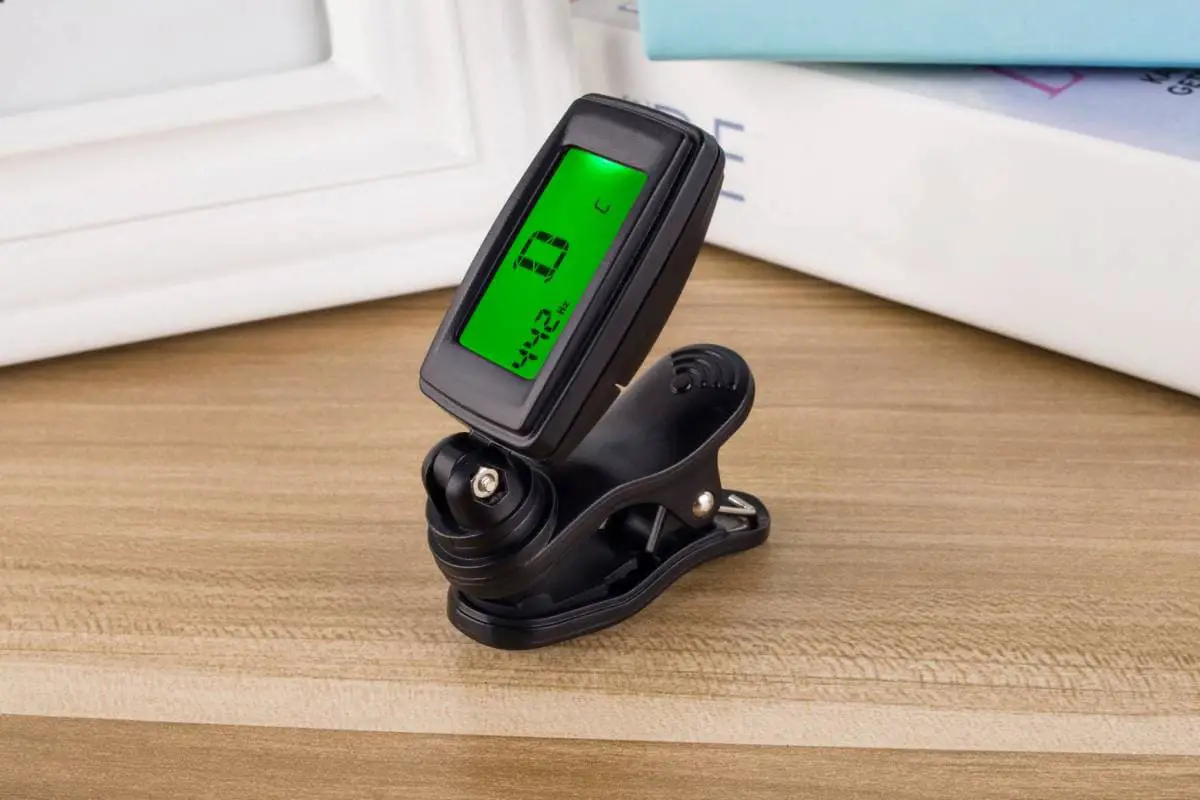The sound quality produced by stringed musical instruments depends on a wide range of factors, including how well the instrument is tuned. Most people cannot tune musical instruments proficiently with their ears alone and thus require the assistance of guitar tuners. Guitar tuners are designed to pick up sounds from vibrating strings and measure frequencies, but what causes guitar tuners to fail, and what fixes are available?
Common causes of a guitar tuner not working include incompatibility with the guitar, using a worn-out guitar tuner, no display on the guitar tuner’s screen, and dirty battery terminals. Fortunately, all of these issues are fixable, meaning a replacement is not always necessary.
In this article, I’ll outline a few issues that cause guitar tuners to stop working correctly. I’ll also talk about the potential fixes you should consider to obtain reliable feedback from your guitar tuner. Keep reading to learn more!
👇😀👇NOTE👇😀👇
If you want to find out what my recommended guitar gear is, then here is what I recommend on Amazon:
- Fender Cutaway Acoustic-Electric Guitar Bundle (MY FAVORITE GUITAR)
- Snark SN-8 Super Tight All Instrument Tuner (Easiest Tuner I’ve Used😏)
- 6 String Acoustic Guitar Capo (Best CAPO for quick changes)
- Dunlop Max Grip 1.0mm Nylon Picks (Thick Guitar Pick So You Don’t Lose Grip!)
- Universal Guitar Stand (Cheap & Minimalist Guitar Stand I Recommend)
- Levy’s 2″ Wide Quick Adjust Guitar Strap (Best Guitar Strap For Any Level)
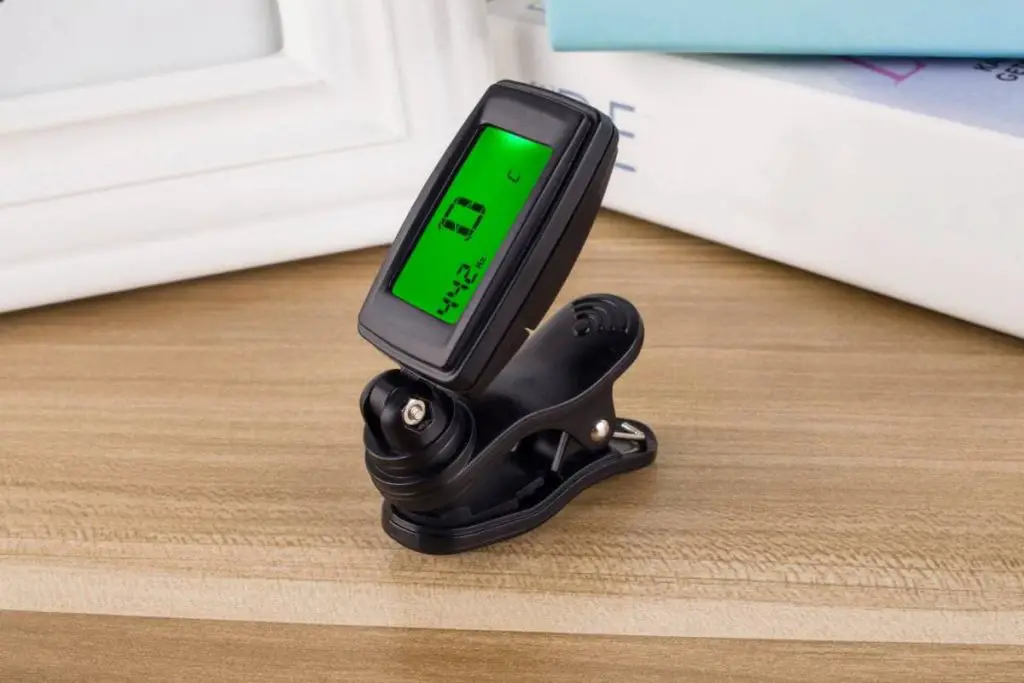
1. Guitar Tuner Incompatibility
Incompatibility is the first common reason your guitar tuner could refuse to work correctly. Guitars are designed for specific guitar types, so using a tuner intended for a different kind of guitar will likely cause no feedback or unreliable results.
Manufacturers design different tuners for electric, acoustic, semi-acoustic guitars, and the standard bass. Therefore, if your guitar tuner is not working from the start, consider testing its compatibility with your instrument before checking for other issues.
When testing if a tuner is compatible with your guitar type, consider the frequencies it picks and whether its design corresponds with the guitar. For instance, a guitar tuner designed for a right-handed instrument can’t work correctly on a left-handed guitar. Therefore, always ensure the guitar tuner you purchase is compatible with the type of guitar you own.
How To Fix
Unfortunately, the only way to fix issues arising from an incompatible guitar tuner is by purchasing a new, compatible one. Always ensure the guitar tuner picks and responds to sound and vibrations from your guitar strings (Related: how to properly hold a guitar pick). You must also ensure the guitar tuner can fit on the headstock well. The headstock’s configuration is essential because it helps you determine the correct type of guitar tuner.
Consider consulting a professional for advice on the best guitar tuner to buy for your instrument. Otherwise, I would recommend purchasing a versatile guitar tuner compatible with multiple stringed instruments. The D’Addario Guitar Tuner (available on Amazon.com) is a versatile and extremely accurate device that is compatible with acoustic, electric, and bass guitars, as well as mandolins, banjos, and ukuleles.
Investing in a universal tuner compatible with multiple instruments minimizes the chances of getting one that does not fit your guitar. Moreover, it guarantees that the tuner performs accurate readings, allowing you to tune your guitar perfectly.
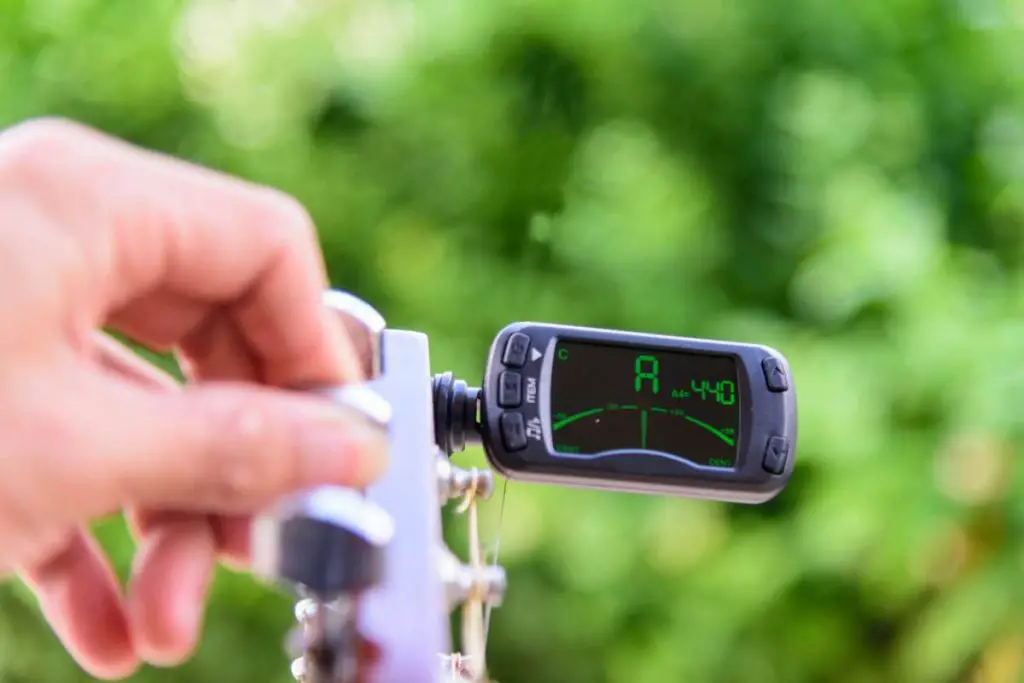
2. Dirty Battery Terminals
The most common problem affecting the performance of compatible guitar tuners usually involves batteries. Guitar tuners generally rely on battery power and thus can’t power on or pick sounds and vibrations if the energy sources are faulty.
Therefore, check the battery compartment and ensure the batteries work fine before giving up on the guitar tuner and seeking a replacement.
Usually, leaving your guitar tuner unattended for a long time causes its batteries to corrode and develop deposits on the terminals. This coating breaks direct contact between the battery terminals and the device, causing the latter to shut down for lack of power.
The battery terminals should always be clean to facilitate efficient power transfer from the batteries to the guitar tuner. Therefore, try not to leave a guitar tuner unused for a long time with batteries left inside.
How To Fix
You can easily restore the proper function in a guitar tuner with corroded battery terminals. You only need some baking soda and a q-tip to scrub the corroded powder stuck on the battery terminals.
Gently rub the baking soda mixture onto both battery terminals and repeat the process until the corroded coating loosens. Afterward, you can use a small piece of cloth and water to wipe out the corrosion and leave clean battery terminals.
This process restores the power supply. If this doesn’t work, the batteries are probably fully discharged and should be replaced.
Guitar tuners typically take CR2032 batteries. Therefore, consider purchasing the Amazon Basics CR2032 Cell Battery (available on Amazon.com) if you need to replace your guitar tuner’s batteries. They’re affordable, long-lasting, and an overall high-value product.

3. Disconnected Battery Contacts
Another cause threatening the proper working of a guitar tuner that also involves the batteries is disconnected battery contacts. Typically, the contacts in the guitar tuner’s battery compartment must stay connected to the terminals for power to flow through and power it. However, multiple factors usually push the connectors too far, thus breaking contact and affecting the guitar tuner’s normal function (Relevant Article: Do locking tuners help stay in tune?).
Therefore, always remember to check if the battery terminals and contacts actually stay connected for energy to flow through the batteries and power the tuner.
How To Fix
If you find out that your guitar tuner is not working well because the contacts aren’t connecting, you should try to restore the connectors to their position. To do this, gently bend the connectors towards the correct position until they are back in contact with the battery terminals.
Make sure this is done carefully and with moderate strength because you can easily break the connectors by bending them too far. Breaking the contacts worsens the situation and may force you to buy a new tuner.
4. No Screen Display
The next common issue you may experience with your guitar tuner is the lack of a screen display. Usually, guitar tuners are equipped with screens to provide the guitar player with feedback. The guitar tuner measures the tone or vibrations and displays the measurement on the screen for you to see.
If the string you played is in the key of C, the guitar tuner displays a C on its screen. These displays are also usually accompanied by color coding and measurements of vibrations in HZ in some tuners for ease in interpreting the guitar tuner’s measurements.
Without a functional screen, the guitar tuner is useless for the most part as you cannot tell the correct tone and make the necessary adjustments.
Usually, the lack of a screen display indicates a contact issue between the tuner’s ball and its headstock. In most cases, the faulty guitar tuner’s screen lights up as you connect it to the headstock before it goes off and offers no response.
How To Fix
To fix the display problem, you need to clip the guitar tuner onto the headstock at a convenient location that holds it in place. You must ensure that this location is suitable for display and allows the device to detect changing pitches from vibrating strings. Once you find a suitable place, glue the shaft and ball while taking care not to glue the tuner to your guitar.
Doing so allows the guitar tuner to stick to a position and display properly while correctly picking sounds and vibrations.
Please take note that this is only a temporary fix to the problem. Therefore, you must plan to replace the guitar tuner with a new one with no display-related issues. If you want a new guitar tuner with no display problems, I recommend purchasing Snark SN5X Clip-On Tuner (available on Amazon.com). It has a full-color display and rotates 360 degrees, making it extremely flexible.
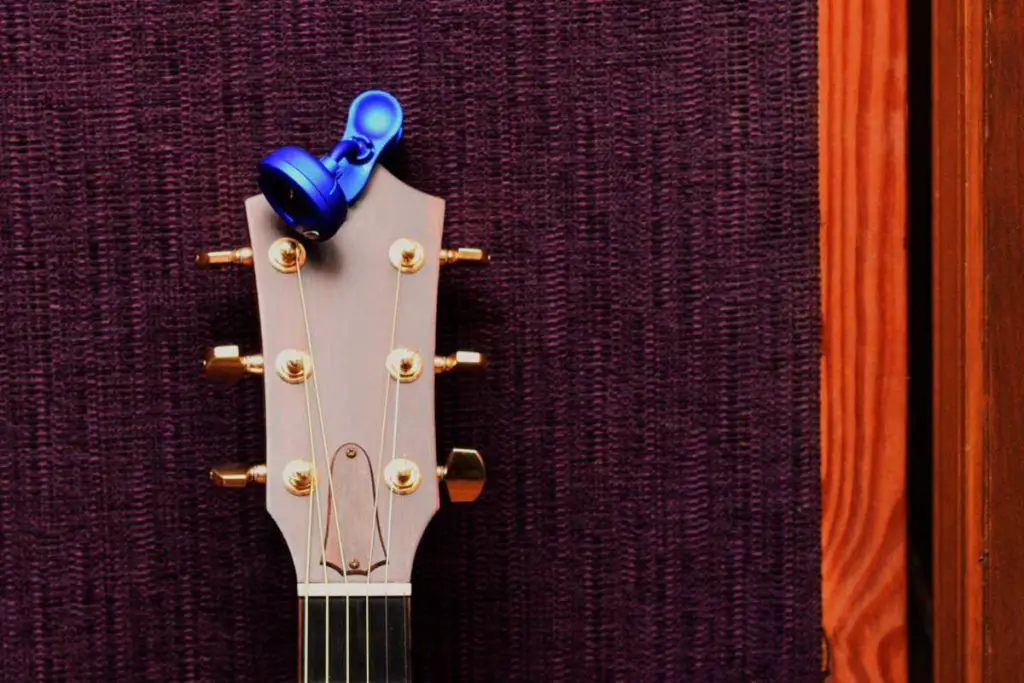
5. Faulty Internal Components
It shouldn’t surprise you that faulty internal components are a leading cause of guitar tuners not working. Guitar tuners have multiple internal components, including the microphone that picks out sounds and vibrations for measurement.
These internal components are designed to pick slight pitch disturbances and vibrations, making them delicate. Therefore, you must take proper care of your guitar tuner for it to last a long time.
Clip-on guitar tuners usually fall off from the headstock, subjecting them to significant damage depending on the height they fell from. Take care of your guitar tuner and protect it from falls that risk damaging its ability to test pitch and vibrations accurately.
How To Fix
I don’t have any specific tips for fixing a guitar tuner with faulty internal components for various reasons. First, fixing individual defective internal components of a guitar tuner can be complicated, as different issues require unique approaches. Therefore, your best option is to take the guitar tuner for repair if you still have its warranty.
Professional technicians understand the repair process and have the necessary repair tools, making them better qualified to perform repairs. Otherwise, you can fix minor internal issues by tapping the guitar tuner a few times and hoping this fixes the problem. If it does not, you have no option but to get a different guitar tuner or consult a professional.
6. The Guitar Tuner Is Clipped Too High
One thing you must never overlook when using a clip-on guitar tuner is the location you connect it. This is because clip-on guitar tuners are more sensitive than other varieties and thus must be clipped at the correct location to detect sound and vibrations.
Clipping the guitar tuner too far and high up the headstock makes detecting vibrations from the strings challenging, thus affecting the guitar tuner’s effectiveness.
This results in the guitar tuner either picking the wrong notes and vibrations or not picking any at all. Therefore, consider checking where the guitar tuner is located if it doesn’t work correctly.
How To Fix
Clip-on guitar tuners usually go in the headstock, where they can accurately measure vibrations emanating from the guitar. If you find out that your guitar tuner isn’t picking up vibrations and offering feedback on adjustments, you should adjust its position and move it to a place where it receives enough vibrations.
Move the clip-on guitar tuner closer to the guitar body so that it’s well-positioned to detect the vibrations and offer accurate feedback from the vibrating strings. You should be mindful of the distance between your guitar tuner and guitar strings.
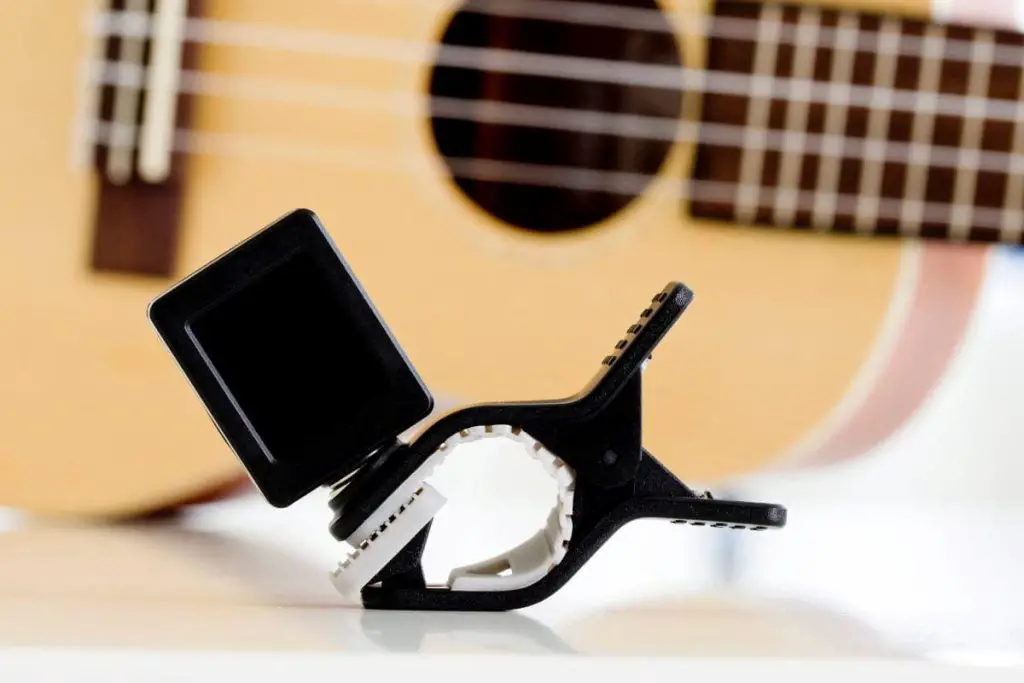
7. The Guitar Tuner Needs Resetting
Sometimes, guitar tuners can develop electronic problems that affect their accuracy and reliability. These electronic problems often stem from repeated calibration of the guitar tuner over time which causes it to jam and offer inaccurate feedback. You may need to reset your guitar tuner to its factory settings for it to resume normal function.
How To Fix
If you notice your guitar tuner has electronic problems unrelated to the batteries and the guitar tuner’s positioning, you should consider resetting it. Like any other device, resetting a guitar tuner is a short and straightforward procedure that doesn’t require much hassle.
Find the small button on the guitar tuner’s front, back, or bottom, depending on the type. Next, long-press it for at least thirty seconds and let go. This causes the guitar tuner to reset to factory settings as though it were brand new. Resetting the guitar tuner is an effective method for fixing electronic issues because it enables the tuner to resolve its own problems. If this fails, consider getting a new guitar tuner.
8. Worn-Out Guitar Tuner
The next common cause of poor or ineffective guitar tuners entails using worn-out ones. Guitar tuners are made of components that wear following repeated and prolonged use. Therefore, if your guitar tuner starts acting up after a long time of continued use, it’s probably worn out.
Worn-out guitar tuners are ineffective because they cannot hold onto the headstock or detect vibrations effectively to enable you to tune your guitar in no time. Worn-out guitar tuners are inefficient and unreliable, making the tuning process harder than it should be.
How To Fix
Worn-out guitar tuners have served their time and thus need to be replaced. While you could try repairing some components to ensure the guitar tuner keeps functioning well, I would suggest getting a new one instead.
Repairing a worn-out guitar tuner only postpones the problem for a little while because you will end up having to purchase a new one eventually. Therefore, make a point of replacing your worn-out guitar tuner with a new one every few months. This ensures that you always have a functional and reliable guitar tuner with you.
9. Incorrect Settings
Another common cause of faulty clip-on guitar tuners involves using the wrong settings. The most common indicator that you are using the wrong settings on your guitar tuner is when the string you pluck and the note displayed on the guitar tuner don’t match.
For instance, if you pluck the C string and the guitar tuner shows that you plucked the D string, the settings are probably off and need adjustments.
Clip-on guitar tuners usually have buttons with letters indicating what settings they represent. C represents chromatic, G represents guitar, B represents bass, V represents violin, and U represents ukulele.
The chromatic setting detects any note and tells you what it is. On the other hand, the other settings are designed to detect the sharpness or flatness of a note. Therefore, ensure you understand these differences to calibrate your guitar tuner to its ideal settings.
How To Fix
If your guitar tuner gives you wrong or inaccurate pitch measurements, consider changing the settings to C (chromatic). This allows you to tell the exact pitch measure and how much adjustment is required after plucking the strings.
Using the chromatic setting guarantees reliable results with no complications, making it suitable for beginners with no technical understanding of music and guitars.
10. Faulty Guitar
The last option you should consider if none of the above fits your case is that your guitar is faulty. If there’s no explanation for your guitar tuner’s failure, consider the possibility that the guitar itself isn’t working properly and thus cannot be tuned.
A weak headstock or an unbalanced bridge is likely to affect the outline of the strings and tamper with the guitar pegs, making it difficult to tune the guitar. For atuner to be effective, the guitar you wish to tune must also be in good condition for accurate measurements of the sound and vibrations produced.
Therefore, ensure your guitar is also of good quality and has reliable tuning pegs, a strong headstock, and a well-positioned bridge.
How To Fix
The only way to get around this issue is to obtain a new guitar. You can also repair the current guitar’s defects before tuning it. Ultimately, remember that the issue can lie in the guitar rather than its tuner. Therefore, remember to check the quality of your guitar’s components, including the neck, headstock, bridge, and pegs, because they are all crucial when it comes to tuning a guitar.
Summary
Guitar tuners can be essential to an enjoyable playing session, especially for beginner guitar players yet to develop perfect pitch and the ability to tune guitars using just their ears. However, they’re not always accurate and can be unreliable for the above reasons.
Fortunately, most of these problems come with easy fixes that you can rely on to fix your guitar tuner and have it produce reliable and efficient pitch and vibration measurements.
👇😀👇NOTE👇😀👇
If you want to find out what my recommended guitar gear is, then here is what I recommend on Amazon:
- Fender Cutaway Acoustic-Electric Guitar Bundle (MY FAVORITE GUITAR)
- Snark SN-8 Super Tight All Instrument Tuner (Easiest Tuner I’ve Used😏)
- 6 String Acoustic Guitar Capo (Best CAPO for quick changes)
- Dunlop Max Grip 1.0mm Nylon Picks (Thick Guitar Pick So You Don’t Lose Grip!)
- Universal Guitar Stand (Cheap & Minimalist Guitar Stand I Recommend)
- Levy’s 2″ Wide Quick Adjust Guitar Strap (Best Guitar Strap For Any Level)
Related Posts:

